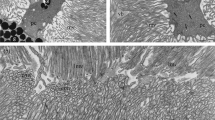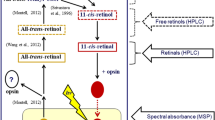Summary
-
1.
Despite the presence of several cell-types in the retina ofLeptograpsus, only one electrophoretic species of acid phosphatase (AcPh) could be detected on acrylamide gels, discounting the existence of more than one isoenzyme proposed by previous authors.
-
2.
Crab retinal AcPh is readily inhibited by low concentrations of fluoride, but D-(+)-tartaric acid is almost without inhibitory effect. No cation requirements could be demonstrated.
-
3.
Electrophoretic data are consistent with a homo-oligomeric quaternary structure for crab retinal AcPh and a 65 KD subunit.
-
4.
AcPh levels were determined throughout the daily cycle using crabs maintained on a 12∶12 h L/D cycle provided by fluorescent lights.
-
5.
Diminution of rhabdom diameter and degradation of internalised membrane during the first 4 h after light-on is reflected by an increase of retinal AcPh which occurs even if the crabs are held in darkness. Lysosomal systems, therefore, can be activated by endogenous factors.
-
6.
AcPh levels in retinae of crabs allowed to experience lights-off at the normal time and in those of crabs held in continuous light over the same period follow identical courses.
-
7.
Cyclical changes in AcPh titres are blurred by high inter-individual variation which is attributed to AcPh pools in systems other than that responsible for degrading photoreceptor membrane. Such sites of activity were demonstrated by ultrastructural cytochemistry to be associated with lipo-protein bodies, the autophagy of pigment granules and the involution of mitochondria. Occasionally, AcPh-positive structures are seen in glia, but under the conditions of these experiments contamination of the retinal samples by patent AcPh derived from the distal lamina appears to be trivial.
-
8.
Possible regulatory mechanisms for the lysosomal systems of arthropod photoreceptors are discussed.
Similar content being viewed by others
Abbreviations
- AcPh :
-
acid phosphatase (orthophosphate monoester phosphohydrolase, E.C. 3.1.3.2.)
- EGTA :
-
ethyleneglycolbis (β-amino-ethyl ether)N,N′-tetra-acetic acid
- PIPES :
-
piperazine N,N′-bis(2-ethane sulphonic acid)
- TRIS :
-
Tris (hydroxymethyl) aminomethane
- SDS :
-
sodium dodecyl sulphate
- PAGE :
-
polyacrylamide gel electrophoresis
References
Adrian GS, Keenan RW (1979) A dolichyl phosphate cleaving acid phosphatase fromTetrahymena pyriformis. Biochim Biophys Acta 575:431–438
Aidells B, Lockshin RA, Cullin AM (1971) Breakdown of the silk glands ofGalleria melonella — acid phosphatase in involuting glands. J Insect Physiol 17:857–869
Barka T, Anderson PH (1962) Histochemical methods for acid phosphatase localisation using hexazonium pararosanilin as coupler. J Histochem Cytochem 10:741–753
Blest AD (1978) The rapid synthesis and destruction of photo-receptor membrane by a dinopid spider: a daily cycle. Proc R Soc Lond [Biol] 200:463–483
Blest AD (1980) Photoreceptor membrane turnover in arthropods: comparative studies of breakdown processes and their implications. In: Williams TP, Baker BN (eds) The effects of constant light on visual processes. Plenum Press, New York, pp 217–245
Blest AD, Kao L, Powell K (1978a) Photoreceptor membrane breakdown in the spiderDinopis: the fate of rhabdomere products. Cell Tissue Res 195:425–444
Blest AD, Powell K, Kao L (1978b) Photoreceptor membrane breakdown in the spiderDinopis: GERL differentiation in the receptors. Cell Tissue Res 195:277–297
Blest AD, Price GD, Maples J (1979) Photoreceptor membrane breakdown in the spiderDinopis: localisation of acid phosphatases. Cell Tissue Res 199:455–472
Blest AD, Stowe S, Price GD (1980) The sources of acid hydrolases for photoreceptor membrane degradation in a grapsid crab. Cell Tissue Res 205:229–244
Bradford M (1976) A rapid and sensitive method for the quantitation of microgram quantities of a protein utilizing the principle of protein-dye-binding. Anal Biochem 82:327–333
Dobrota M, Hinton RH, El-Aaser AAA, Fitzsimmons JTR, Reid E (1978) Membrane association may limit the use of acid phosphatase as a lysosomal marker. Biochem Soc Trans 6:291–293
Duve C De (1978) An integrated view of lysosome function. In: Berlin RD, Herman H, Lepow IH, Tanzer JM (eds) Molecular basis of biological degradative processes. Academic Press, New York, pp 25–38
Eguchi E, Waterman TH (1967) Changes in retinal fine structure induced in the crabLibinia by light and dark adaptation. Z Zellforsch 79:209–229
Eguchi E, Waterman TH (1976) Freeze-etch and histochemical evidence for cycling in crayfish photoreceptor membranes. Cell Tissue Res 169:419–434
Griffiths GW (1979) Transport of glial cell acid phosphatase by endoplasmic reticulum into damaged axons. J Cell Sci 36:361–389
Hafner GS, Bok D (1977) The distribution of3H-leucine labelled protein in the retinula cells of the crayfish retina. J Comp Neurol 174:397–416
Hafner GS, Hammond-Soltis G, Tokarski T (1980) Diurnal changes of lysosome-related bodies in the crayfish photoreceptor cells. Cell Tissue Res 206:319–332
Henrikson PA, Clever U (1972) Protease activity and cell death during metamorphosis in the salivary gland ofChironomus tentans. J Insect Physiol 18:1981–2004
Hollander VP (1971) Acid phosphatase. In: Boyer PD (ed) The enzymes, vol 4. Academic Press, New York, pp 449–498
Horridge GA, Duniec J, Marcelja L (1981) A 24-hour cycle in single locust and mantis photoreceptors. J Exp Biol 91:307–322
Kilsheimer GS, Axelrod B (1957) Inhibition of prostatic acid phosphatase by α-hydroxycarboxylic acids. J Biol Chem 227:879–890
Laemmli UK (1970) Cleavage of structural proteins during the assembly of the head of bacteriophage T4. Nature 227:680–685
Lenney JF, Tolan JR, Sugai WJ, Lee AG (1979) Thermostable endogenous inhibitors of cathepsins B and H. Eur J Biochem 101:153–161
Locke M, Sykes AK (1975) The role of the Golgi complex in the isolation and digestion of organelles. Tissue Cell 7:143–158
Lowry OH, Roseborough NJ, Farr L, Randall J (1951) Protein measurements with the Folin phenol reagent. J Biol Chem 193:265–275
MacIntyre RJ (1971) A method for measuring activities of acid phosphatases separated by acrylamide gel electrophoresis. Biochem Genet 5:45–56
MacIntyre RJ, Dean MR (1967) Sub-units of acid phosphatase-I inDrosophila melanogaster: reversible dissociation in vitro. Nature 214:274–275
McDonald BH, Schofield BH, Geffert MA, Coleman RA (1980) A comparative study of new substrates for the histochemical demonstration of acid phosphomonoesterase activity in tissues which secrete phosphatase. J Histochem Cytochem 28:316–322
Morgan RA, Inge KL, Chrisopher CW (1981) Localization and characterization of N-ethylmaleimide sensitive inhibitors of thiol cathepsin activity from cultured Nil and polyoma virus-transformed Nil hamster cells, J Cell Physiol 108:55–66
Novikoff AB, Novikoff PM (1977) Cytochemical contributions to differentiating GERL from the Golgi apparatus. Histochem J 9:525–551
Pelt-Verkuil E Van (1979) Hormone-related induction of acid phosphatase activity in the fat body ofCalliphora erythrocephala prior to metamorphosis. J Insect Physiol 25:965–973
Rothschild J (1966) Amoeba acid phosphatases. I. An intracellular inhibitor for particle-associated acid phosphomonoesterase. C R Trav Lab Carlsberg Ser Chim 35:391–418
Sammons DW, Adams LD, Nishizawa EE (1981) Ultrasensitive silver-based color staining of polypeptides in polyacrylamide gels. Electrophoresis 2:135–141
Schin K, Laufer H (1973) Studies of programmed salivary gland regression during larval-pupal transformation inChironomus thummi. I. Acid hydrolase activity. Exp Cell Res 82:335–340
Skudlarek MD, Swank RT (1981) Turnover of two lysosomal enzymes in macrophages. J Biol Chem 256:10137–10144
Smith JK, Whitby LG (1968) The heterogeneity of acid phosphatase. Biochim Biophys Acta 151:607
Stowe S (1980) Rapid synthesis of photoreceptor membrane and assembly of new microvilli in a crab at dusk. Cell Tissue Res 211:419–440
Stowe S (1981) Effects of illumination changes on rhabdom synthesis in a crab. J Comp Physiol 142:19–25
Trimble RB, Maley F, Watorek W (1981) Subunit structure and carbohydrate composition of the extracellular acid phosphatase ofRhodotorula glutinis. J Biol Chem 256:10037–10043
White RH (1967) The effect of light and light deprivation upon the structure of the larval mosquito eye. II. The rhabdom. J Exp Zool 166:405–525
White RH (1968) The effect of light and light deprivation upon the structure of the larval mosquito eye. III. Multivesicular bodies and protein uptake. J Exp Zool 169:261–268
White RH, Lord E (1975) Diminution and enlargement of the mosquito rhabdom in light and darkness. J Gen Physiol 65:583–598
White RH, Gifford D, Michaud NA (1980) Turnover of photoreceptor membrane in the larval mosquito ocellus: rhabdomeric coated vesicles and organelles of the vacuolar system. In: Williams TP, Baker BN (eds) The effects of constant light on visual processes. Plenum, New York, pp 271–296
Williams DS (1982a) Ommatidial structure in relation to photoreceptor membrane turnover in a locust. Cell Tissue Res 225:595–617
Williams DS (1982b) Photoreceptor membrane shedding and assembly can be initiated locally within an insect eye. Science (in press)
Williams DS, Blest AD (1980) Extracellular shedding of photoreceptor membrane in the open rhabdom of a tipulid fly. Cell Tissue Res 205:423–438
Author information
Authors and Affiliations
Rights and permissions
About this article
Cite this article
de Couet, H.G., Blest, A.D. The retinal acid phosphatase of a crab,Leptograpsus: Characterisation, and relation to the cyclical turnover of photoreceptor membrane. J. Comp. Physiol. 149, 353–362 (1982). https://doi.org/10.1007/BF00619151
Accepted:
Issue Date:
DOI: https://doi.org/10.1007/BF00619151




